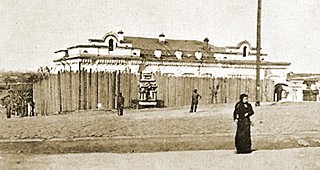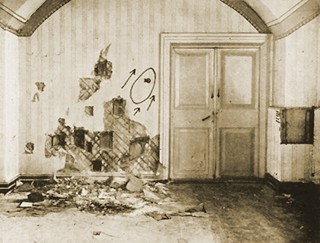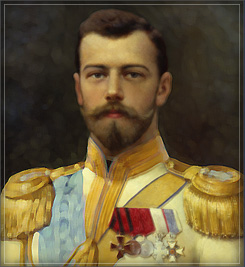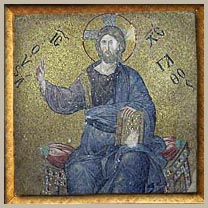This another page from my Hagia Sophia webite that will be of interest to anyone who is interested in the church of the Theotokos Pammakaristos.



Ekaterinburg - Murder of the Imperial Family - Pierre Gilliard - Thirteen Years at the Russian Court
THE NIGHT OF JULY 16-17th, 1918
On our arrival at Tyumen on May 22nd we were at once taken, under a strong escort, to the special train that was to take us to Ekaterinburg. Just as I was getting into the train with my pupil I was separated from him and put in a fourth-class carriage, guarded by sentries like the others. We reached Ekaterinburg in the night, the train being stopped at some distance from the station.
About nine o'clock the next morning several carriages were drawn up alongside our train, and I saw four men go towards the children's carriage.
A few minutes passed and then Nagorny, the sailor attached to Aleksey Nicolaievich, passed my window, carrying the sick boy in his arms; behind him came the Grand-Duchesses, loaded with valises and small personal belongings. I tried to get out, but was roughly pushed back into the carriage by the sentry.
I came back to the window. Tatiana Nicolaievna came last, carrying her little dog and struggling to drag a heavy brown valise. It was raining, and I saw her feet sink into the mud at every step. Nagorny tried to come to her assistance; he was roughly pushed back by one of the commissaries... A few later the carriages drove off with the children in the of the town. How little I suspected that I was never to see them again, after so many years among them I was convinced that they would come back and fetch us and that we should be united without delay.
But the hours passed. Our train was shunted back into the station, and then I saw General Tatichtchev, Countess Hendrikova, and Mlle. Schneider being taken away. A little later it was the turn of Volkov, the Tsarina's valet-de-chambre, de Kharitonov, the chef, Trupp, the-footman, and little Leonid Sedniev, a kitchen boy of fourteen.
With the exception of Volkov, who managed to escape later, and little Sedniev, whose life was spared, not one of those who were led off that day was destined to escape alive from the hands of the Bolsheviks.
We were still kept waiting. What was happening? Why didn't they come for us too? We gave ourselves up to all sorts of hypotheses, when, about five o'clock, Commissary Rodionov, who had come to Tobolsk to fetch us, entered our carriage and told us we were not wanted and were free.
Free! What was this? We were to be separated from the others? Then all was over! The excitement that had sustained us up to now gave place to deep depression. What was to be done? What was to be the next move? We were overwhelmed.
Even today I cannot understand what prompted the Bolsheviks to this decision to save our lives. Why, for instance, should Countess Hendrikova be taken to prison while Baroness de Buxhoeveden, also a lady-in-waiting to the Tsarina, was allowed to go free? Why they and not ourselves? Was there confusion of names or functions? A mystery!
On the next and following days I and my colleague went to see the English and Swedish consuls - the French consul was away; at all costs something had to be done to help the prisoners. The two consuls relieved our minds by telling us that proceedings had already been taken and that they did not think there was any imminent danger.
I must pay a tribute to the very courageous conduct of the British Consul, Mr. Preston, who did not shrink from open conflict with the Bolshevik Authorities at the risk of compromising his personal safety.

Above; outside of the Ipatiev House. A secret picture taken soon after the arrival of the Romanovs.
I walked past Ipatiev's house, of which the tops of the windows could be seen above the wall of boards that hemmed it in. I had not yet lost all hope of effecting an entry, for Dr. Derevenko, who had been allowed to visit the boy, had heard Dr. Botkin ask Commissary Avdiev, the commandant of the guard, on behalf of the Tsar, that I should be allowed to rejoin them. Avdiev had replied that he would refer the matter to Moscow. Meanwhile, my companions and I, except Dr. Derevenko, who had taken lodgings in the town, camped in the fourth-class carriage which had brought us We were destined to remain there for more than a month!
On the twenty-sixth we were ordered to leave the territory of the Perm Government - which includes Ekaterinburg - without delay and return to Tobolsk. Care had been taken that we should only have one document between us, to keep us together and so facilitate supervision. But the trains were no longer running. The anti-Bolshevik movement of the Russian and Czech volunteers was spreading rapidly, and the line was exclusively reserved for the military units that were being hurried to Tyumen. This meant further delay.
GILLIARD NOTE: In May, 1918, the Czecho-Slovakian troops (consisting of volunteers, former prisoners of war), who had by then been developed by Kerensky into two strong divisions, were strung along the Trans-Siberian railway between Samara and Vladivostok; preparations were being made to pass them into France. The German G.H.Q., in an attempt to prevent these troops from rejoining the allied forces in Europe, ordered the Bolsheviks to disarm them. Following on an ultimatum that was rejected by the Czechs, fighting broke out between them and the Bolshevik troops under German officers. The Russian volunteer formations lost no time in joining up with the Czecho-Slovakian troops. Such was the origin of the movement which began at Omsk and soon spread over the whole of Siberia.
One day when I was passing Ipatiev's house, accompanied by Dr. Derevenko and Mr. Gibbes, we saw two carriages drawn up and surrounded by a large number of Red Guards, What was our horror at recognizing in the first Sedniev (the valet-de-chambre of the Grand-Duchesses) sitting between two guards. Nagorny was going to the second carriage. He was just setting foot on the step with his hand on the side of the carriage when, raising his head, he saw us all there standing motionless a few yards from him. For a few seconds he looked fixedly at us, then, without a single gesture that might have betrayed us, he took his seat. The carriages were driven off, and we saw them turn in the direction of the prison.
These two good fellows were shot shortly afterwards; their sole crime had been their inability to hide their indignation on seeing the Bolshevik commissaries seize the little gold chain from which the holy images hung over the sick bed of Aleksey Nicolaievich.
A few more days passed, and then I learned through Dr. Derevenko that the request made on my behalf had been refused.
On June 3rd our carriage was coupled to one of the many trains loaded with starving people from Russia coming to look for food in Siberia. We made for Tyumen, where, after various wanderings, we finally arrived on the fifteenth A few hours later I was placed under arrest by Bolshevik headquarters, where I had been forced to apply for a visa that was indispensable to my companions and myself. It was only by a lucky combination of circumstances that I came to be released in the evening and was able to get back to the railway carriage, in which they were waiting for me. The following days were days of indescribable anxiety, at the mercy of any chance that might call attention to us. Probably what saved us was that we were lost in the crowd of refugees who filled Tyumen station, and so managed to pass unnoticed.
On July 20th the Whites, as the anti-Bolshevik troops were called, captured Tyumen and saved us from the fanatics who had so nearly claimed us as victims. A few days later the papers published a reproduction of the proclamation that had been placarded in the streets of Ekaterinburg, announcing that the sentence of death passed on the ex-Tsar Nicholas Romanov had been carried out on the night of July 16th-17th and that the Tsarina and her children had been removed to a place of safety.
At last, on July 25th, Ekaterinburg fell in its turn. Hardly was communication re-established which took a long time as the permanent way had suffered severely - when Mr. Gibbes and I hastened to the town to search for the Imperial family and those of our companions who had remained at Ekaterinburg.
Two days after my arrival I made my first entry into Ipatiev's house. I went through the first-floor rooms, which had served as the prison; they were in an indescribable state of disorder. It was evident that every effort had been made to get rid of any traces of the recent occupants. Heaps of ashes had been raked out of the stoves. Among them were a quantity of small articles, half burnt, such as toothbrushes, "hairpins, buttons, etc., in the midst of which I found the end of a hair-brush on the browned ivory of which could still be seen the initials of the Tsarina, A. F. (Alexandra-Feodorovna).
If it was true that the prisoners had been sent away, they must have been removed just as they were, without any of the most essential articles of toilet.
I then noticed on the wall in the embrasure of one of the windows of Their Majesties' room the Empress's favorite charm, the swastika (the swastika is an Indian religious symbol consisting of a cross of equal limbs, their extremities bent to the left), which she had put up everywhere to ward off ill-luck. She had drawn it in pencil, and added, underneath, the date, 17/ 3o April, the day of their incarceration in the house. The same symbol, but without the date, was drawn on the wallpaper, on a level with the bed, occupied doubtless by her or Aleksey Nicolaievich. But my search was to no purpose, I could not find the slightest clue to their fate.

Above; the murder room. This photo was taken after the room had been torn up in search of bullets and other evidence by investigators.
I went down to the bottom floor, the greater part of which was below the level of the ground. It was with intense emotion that I entered the room in which perhaps - I was still in doubt - they had met their death. Its appearance was sinister beyond expression. The only light filtered through a barred window at the height of a man's head. The walls and flour showed numerous traces of bullets and bayonet scars. The first glance showed that an odious crime had been perpetrated there and that several people had been done to death. But who? How?
I became convinced that the Tsar had perished and, granting that, I could not believe that the Tsarina had survived him. At Tobolsk, when Commissary Yakovlev had come to take away the Tsar, I had seen her throw herself in where the danger seemed to her greatest. I had seen her, brokenhearted after hours of mental torture, torn desperately between her feelings as a wife and a mother, abandon her sick boy to follow the husband whose life seemed in danger. Yes, it was possible they might have died together, the victims of these brutes. But the children? They too massacred? I could not believe it. My whole being revolted at the idea. And yet everything proved that there had ken many victims. Well, then?...
During the following days I continued my investigations in Ekaterinburg and its suburbs - the monastery, everywhere I could hope to find the lightest clue. I saw Father Storoyev, who had been the last to conduct religious service in Ipatiev's house, on Sunday, the 14th, two days before the night of terror. He too, alas, had very little hope.
The enquiry proceeded very slowly. It was begun in extremely difficult circumstances, for, between July 17th and 25th the Bolshevik commissaries had had time to efface nearly every trace of their crime. Immediately after the taking of Ekaterinburg by the Whites, the military authorities had surrounded the house with a guard and a judicial enquiry had been opened, but the threads had been so skillfully entangled that it was very difficult to sort them out.
The most important deposition was that of some peasants from the village of Koptiaki, twenty versts north-west of Ekaterinburg. They came to give evidence that on the night of July 16th-17th the Bolsheviks had occupied a clearing in a forest near their village, where they had remained several days. They brought with them objects which they had found near the shaft of an abandoned mine, not far from which could be seen traces of a large fire. Some officers visited the clearing and found other objects which, like the first, were recognized as having belonged to the Imperial family.
The enquiry had been entrusted to Ivan Alexandrovich Sergeiev, a member of the Ekaterinburg tribunal. It followed a normal course, but the difficulties were very great.
Sergeiev was more and more inclined to admit the death of all the members of the family. But the bodies could still not be found, and the depositions of a certain number of witnesses supported the hypothesis that the Tsarina and the children had been removed to another place. These depositions as was subsequently established - emanated from Bolshevik agents deliberately left in Ekaterinburg to mislead the enquiry. Their end was partially attained, for Sergeiev lost precious time and was long in realising that he was on the wrong track.
The weeks passed without bringing any new information. I then decided to return to Tyumen, the cost of living at Ekaterinburg being very high. Before starting, however, I obtained from Sergeiev a promise that he would recall me if any new fact of importance came to light in the course of the enquiry.
At the end of January, 1919, I received a telegram, from General Janin, whom I had known at Moghilev when he was chief of the French Military Mission at Russian G.H.Q. He invited me to join him at Omsk. Some days later I left Tyumen, and on February 13th arrived at the Military Mission sent by France to the Omsk Government.
GILLIARD NOTE: The Allies had resolved to exploit the anti-BoIshevik movement which had developed in Siberia and to make immediate use of the Czecho-Slovakian troops by creating on the Volga a new front against the Germano-Bolshevik troops, which might create a diversion and hold back part of the German forces freed by the treaty of Brest-Litovsk. Hence the despatch by France and England of civil and military missions to Siberia. The anti-Bolshevik Government of Omsk was at that time controlled by Admiral Kolchak.
Admiral Kolchak, realising the historic importance of the enquiry into the disappearance of the Imperial family, and wishing to know the result, had in January charged General Diteriks to bring him from Ekaterinburg a copy of the evidence and all the clues that had been found. On February 5th he summoned Nicholas Alexievich Sokolov, "Examining Magistrate,"(There were three categories of Examining Magistrates: (a) Examining Magistrates for ordinary business; (b) Examining Magistrates for important business; (c) Examining Magistrates for business of particular importance) for business of particular importance, and invited him to conduct the enquiry. Two days later the Minister of justice appointed him to carry on Sergeiev's work.
It was at this juncture that I made the acquaintance of M. Sokolov. At our first interview I realised that his mind was made up and that he had no further hope. I could not believe such horrors. "But the children-the children ?" I cried to him. "The children have suffered the same fate as their parents. There is not a shadow of doubt in my mind on that point." "But the bodies ? The clearing must be searched; that is where we shall find the key to the mystery, for the Bolsheviks cannot have spent three days and nights there simply to burn a few clothes."
Alas! these conclusions were soon to be borne out by the deposition of one of the principal murderers, Paul Medvedev, who had just been taken prisoner at Perm. As Sokolov was at Omsk it was Sergeiev who interrogated him on February 25th at Ekaterinburg. He admitted formally that the Tsar, Tsarina and the five children, Dr. Botkin, and the three servants had been killed in the basement of Ipatiev's house during the night of July 16th-17th. He could not, however, or would not, give any hint as to what had been done with the bodies after the murder.
I worked for several days with M. Sokolov; then he left or Ekaterinburg to continue the enquiry opened by Sergeiev.
In April, General Diteriks, who was returning from Vladivostok - where he had been sent by Admiral Kolchak on a special mission - came to join him and assist his efforts.
Thenceforward the enquiry made rapid progress. Hundreds of persons were interrogated, and, as soon as the snow had gone, work was begun on a large scale in the clearing in which the Koptiaki peasants had found articles belonging to the Imperial family. The mine-shaft was emptied and thoroughly examined. The ashes and soil of part of the clearing were passed through sieves, and the whole of the surrounding area carefully examined. They succeeded in determining the site of two large fires and, more vaguely, the traces of a third, This methodical research soon brought discoveries of extreme importance.
Devoting himself wholeheartedly to the work he had undertaken, and displaying untiring patience and diligence, M. Sokolov was able in a few months to reconstruct every circumstance of the crime with remarkable accuracy.







